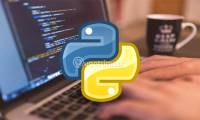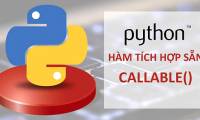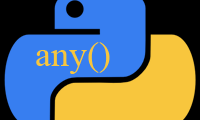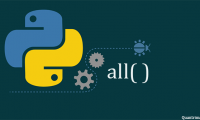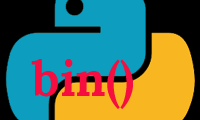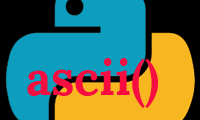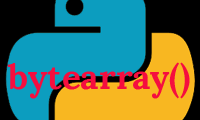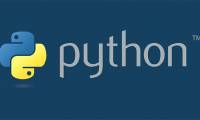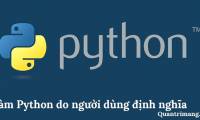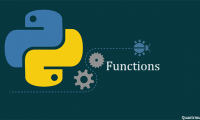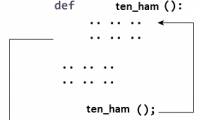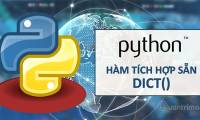
in python, the dict () function creates a dictionary type value. quantrimang will learn more about the syntax, parameters and usage of the dict () function through this article.
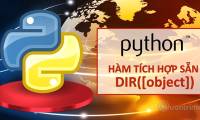
the dir () function in python returns a list of valid properties of the object. quantrimang will learn more about this function content through the article. invites you to read
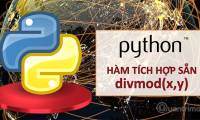
learn more about the syntax, parameters and usage of the built-in divmod () function in python with quantrimang.

in python, the enumerate () function adds a counter before each iterable and returns the result as an enumerate object. the article will elaborate on the syntax, parameters and

the float () function in python converts the value specified to a floating-point number. how does the float () function have a syntax, what parameters do you have, how can you

in this article, quantrimang will continue to introduce you to a built-in function in python, eval (). eval () is an interesting utility that allows you to run python code (this

the hex () function is one of python's built-in functions, used to convert an integer into the corresponding hexadecimal form.

the exec () function used to execute python programs dynamically can be string or object code. how does exec () function syntax, what parameters do it have, and how is it used?

callable () in python checks whether objects can be called. if the object is allowed to call, the function returns true, otherwise it returns false. how does the callable ()

in python, the chr () function returns a character (a string) from an integer that represents the unicode of the returned character.

in python, any () function returns true if any element of an iterable is true. if no true element is present, any () function will return false.

in python, all () returns true when all iterable elements are true or iterable empty and return false in the remaining cases. how does the function all () have syntax, what

in python programming, the bin () function converts and returns the binary string of the given integer. so what is the syntax of bin () function, parameters and how to use bin ()?

in python, the ascii () function returns a string containing the representation of the object that can print. it ignores non-ascii values in the string using x, u or u.

in the python programming language, bool () is used to convert values to boolean (true or false) using standard truth test procedures. so how to use bool () function? please

bytearray () function in python returns the bytearray object of a given byte array. how is the syntax of bytearray () function, what parameters does it have and how to use it?

in the previous article we learned about the built-in python function and the user-defined python function with customizable number of parameters. you will know how to define a

besides the built-in python functions, you can also define python functions yourself, these functions are called user-defined functions (python). what are the benefits of using

in the previous article, you learned that python has a basic function type, one is a built-in function, two are user-defined functions. today, we will learn about a list of

what is python function? how is the syntax, components, and function types in python? how to create functions in python? these questions will be answered in the python lesson
 in python, the dict () function creates a dictionary type value. quantrimang will learn more about the syntax, parameters and usage of the dict () function through this article.
in python, the dict () function creates a dictionary type value. quantrimang will learn more about the syntax, parameters and usage of the dict () function through this article. the dir () function in python returns a list of valid properties of the object. quantrimang will learn more about this function content through the article. invites you to read
the dir () function in python returns a list of valid properties of the object. quantrimang will learn more about this function content through the article. invites you to read learn more about the syntax, parameters and usage of the built-in divmod () function in python with quantrimang.
learn more about the syntax, parameters and usage of the built-in divmod () function in python with quantrimang. in python, the enumerate () function adds a counter before each iterable and returns the result as an enumerate object. the article will elaborate on the syntax, parameters and
in python, the enumerate () function adds a counter before each iterable and returns the result as an enumerate object. the article will elaborate on the syntax, parameters and the float () function in python converts the value specified to a floating-point number. how does the float () function have a syntax, what parameters do you have, how can you
the float () function in python converts the value specified to a floating-point number. how does the float () function have a syntax, what parameters do you have, how can you in this article, quantrimang will continue to introduce you to a built-in function in python, eval (). eval () is an interesting utility that allows you to run python code (this
in this article, quantrimang will continue to introduce you to a built-in function in python, eval (). eval () is an interesting utility that allows you to run python code (this the hex () function is one of python's built-in functions, used to convert an integer into the corresponding hexadecimal form.
the hex () function is one of python's built-in functions, used to convert an integer into the corresponding hexadecimal form. the exec () function used to execute python programs dynamically can be string or object code. how does exec () function syntax, what parameters do it have, and how is it used?
the exec () function used to execute python programs dynamically can be string or object code. how does exec () function syntax, what parameters do it have, and how is it used? callable () in python checks whether objects can be called. if the object is allowed to call, the function returns true, otherwise it returns false. how does the callable ()
callable () in python checks whether objects can be called. if the object is allowed to call, the function returns true, otherwise it returns false. how does the callable () in python, the chr () function returns a character (a string) from an integer that represents the unicode of the returned character.
in python, the chr () function returns a character (a string) from an integer that represents the unicode of the returned character. in python, any () function returns true if any element of an iterable is true. if no true element is present, any () function will return false.
in python, any () function returns true if any element of an iterable is true. if no true element is present, any () function will return false. in python, all () returns true when all iterable elements are true or iterable empty and return false in the remaining cases. how does the function all () have syntax, what
in python, all () returns true when all iterable elements are true or iterable empty and return false in the remaining cases. how does the function all () have syntax, what in python programming, the bin () function converts and returns the binary string of the given integer. so what is the syntax of bin () function, parameters and how to use bin ()?
in python programming, the bin () function converts and returns the binary string of the given integer. so what is the syntax of bin () function, parameters and how to use bin ()? in python, the ascii () function returns a string containing the representation of the object that can print. it ignores non-ascii values in the string using x, u or u.
in python, the ascii () function returns a string containing the representation of the object that can print. it ignores non-ascii values in the string using x, u or u. in the python programming language, bool () is used to convert values to boolean (true or false) using standard truth test procedures. so how to use bool () function? please
in the python programming language, bool () is used to convert values to boolean (true or false) using standard truth test procedures. so how to use bool () function? please bytearray () function in python returns the bytearray object of a given byte array. how is the syntax of bytearray () function, what parameters does it have and how to use it?
bytearray () function in python returns the bytearray object of a given byte array. how is the syntax of bytearray () function, what parameters does it have and how to use it? in the previous article we learned about the built-in python function and the user-defined python function with customizable number of parameters. you will know how to define a
in the previous article we learned about the built-in python function and the user-defined python function with customizable number of parameters. you will know how to define a besides the built-in python functions, you can also define python functions yourself, these functions are called user-defined functions (python). what are the benefits of using
besides the built-in python functions, you can also define python functions yourself, these functions are called user-defined functions (python). what are the benefits of using in the previous article, you learned that python has a basic function type, one is a built-in function, two are user-defined functions. today, we will learn about a list of
in the previous article, you learned that python has a basic function type, one is a built-in function, two are user-defined functions. today, we will learn about a list of what is python function? how is the syntax, components, and function types in python? how to create functions in python? these questions will be answered in the python lesson
what is python function? how is the syntax, components, and function types in python? how to create functions in python? these questions will be answered in the python lesson
